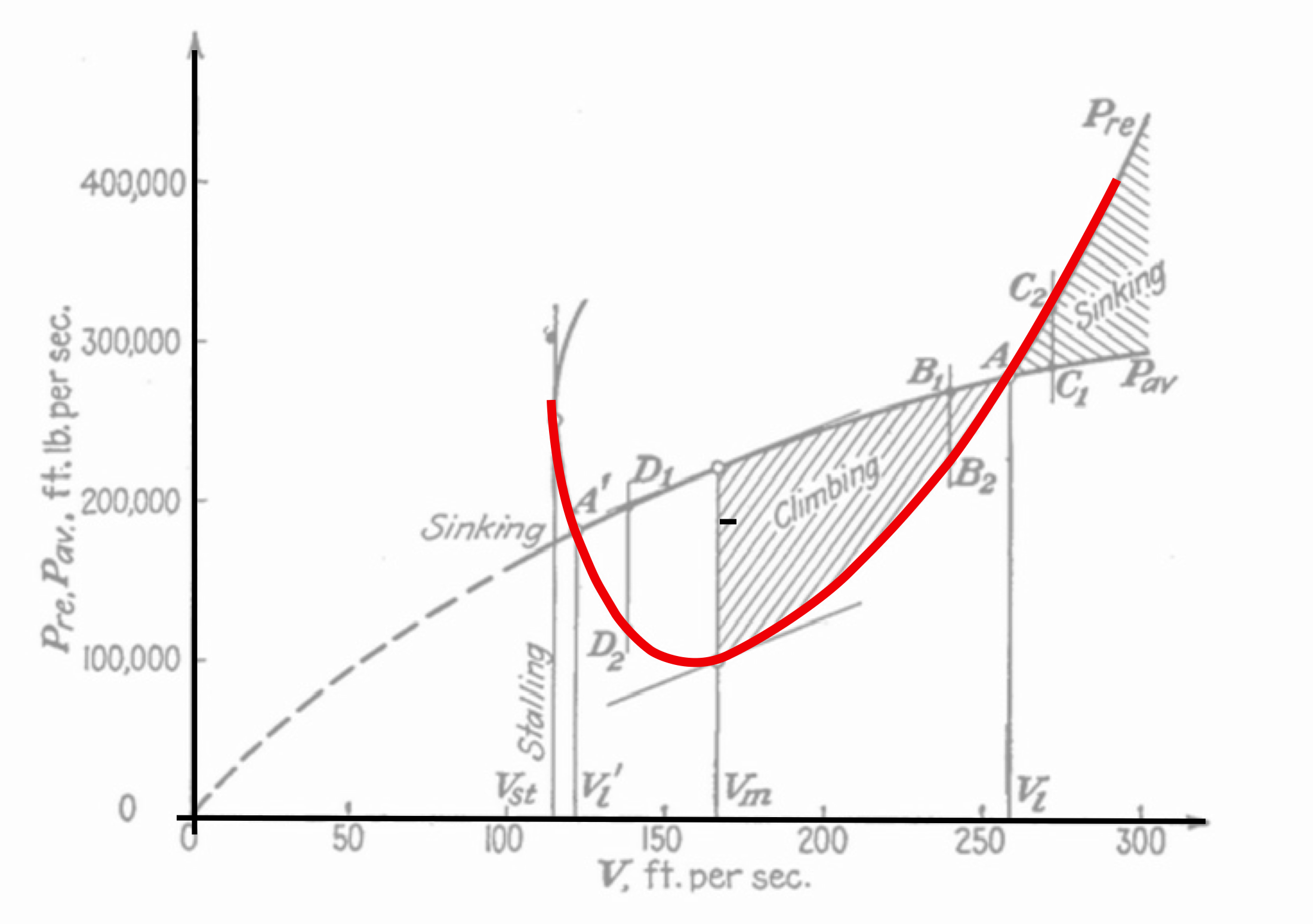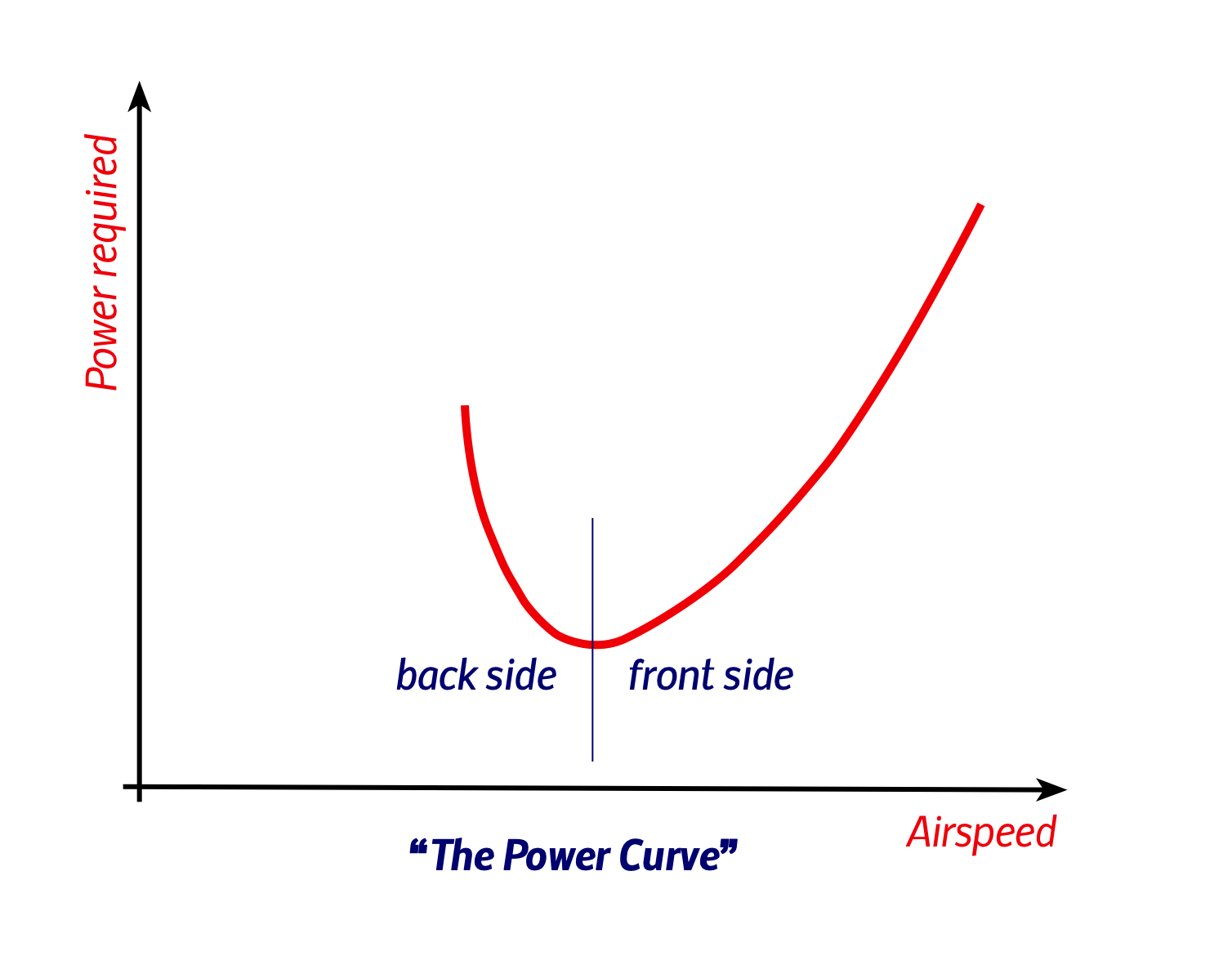Front side of the curve

by
Posted
The “power required” curve for a sample airplane, from Theory of Flight (Richard Von Mises, McGraw Hill, 1945). 150 feet per second on the horizontal scale corresponds to about 90 knots, and 100,000 ft.lb per sec. on the vertical scale is about 180 bhp, so this aircraft is faster and more powerful than a modern training aircraft but the shape of the curve still applies.
Raising the nose
The scenario: our single-engined training aircraft airplane is set up in a stable descent on approach to land. The configuration is appropriate, perhaps with partial or full flaps extended. Airspeed is somewhere between 60 and 80 knots. What happens to the flight path of the airplane if the pilot pulls back on the yoke and raises the nose? Stop and think about the answer for a minute, then read on.
Short term response
Before we start, the aircraft is in a steady state descent: the forces are in balance and the power from the engine and the gravitational potential energy released by the descent are exactly enough to pay for the work the airplane is doing moving against drag.

The short-term response to a pull-back on the yoke is for the aircraft to “balloon” upwards and to slow down. The balloon occurs due to the increase in angle of attack creating an increase in lift which causes an immediate upward vertical acceleration. 1
The slow-down occurs because with the airplane not coming down as fast, not enough gravitational energy is being released to pay for the drag at the old airspeed. This is like a car starting up an incline: without added engine power it will slow down. John Denker calls it the law of the roller coaster in his excellent (but very technical) online book See How It Flies.
As an aside, the balloon doesn’t have to cause an increase in altitude: it could just be a sudden relaxation in the rate of descent.
The short term response is over in about three or four seconds, but what happens next is more interesting.
Long term response
Once the the angle of attack has increased and the airspeed decreased, and the vertical acceleration has ceased (because the forces are back in balance) how does flight path angle – the angle of descent – differ from before? The answer depends on whether the aircraft is on the front side or the back side of the power curve.

The power curve relates the power required to maintain stable flight (along the vertical axis) against airspeed (horizontal axis). To fly either very fast or very slow both require a lot of power; To fly at intermediate speeds requires less power. The very bottom of the curve is at the airspeed at which the aircraft can fly using a minimum amount of power – this is pretty close to the airspeed for “best endurance” which you will recall from your pilot training.
We say that an aircraft is flying on the front side or back side of the power curve when it flies faster or slower than the minimum power airspeed, respectively.
If the airplane stays on the front side of the power curve – the airspeed remains faster than the minimum power airspeed – pulling on the yoke causes
- a decrease in airspeed, and,
- since maintaining steady flight at the lower airspeed requires less power,
- a slower rate of descent and a shallower flightpath.2
If the airspeed is slower than the minimum power airspeed (and is on the back side of the power curve) pulling on the yoke causes
- a decrease in airspeed, and,
- since maintaining steady flight at the lower airspeed requires more power,
- a faster rate of descent and a steeper flightpath.
In this case the long term response is opposite to the short term response.
Here it is in pictures, exaggerated for clarity:

You will deduce that there will also be a range of airspeeds, close to the minimum power airspeed, where the long term response to a small pull on the yoke is to descend at close to the same – or at exactly the same – angle as it did before.
Lowering the nose
What happens if the pilot lowers the nose instead?

Practical results
What happens to the airplane in the long term depends on whether we’re faster or slower than minimum power speed. And what is that minimum power airspeed? You will never be exactly sure. For a single engine training plane it’s somewhere around 60 to 70 knots, depending on weight and whether the flaps are up or down. Crucially there’s a good chance we are making our approach at or very close to this airspeed, without having thought much about it.
In early flight training we spend a lot of time practicing pulling back on the yoke to go up, and pushing on the yoke to go down, both of which work really well when flying at speed. But when flying a slow descent we have to break that habit, because it doesn’t work: if your speed is close to where it should be on approach (close to that minimum power airspeed) pulling the yoke will decrease the airspeed but have minimal effect on where the airplane goes. Doubly unhelpfully, you get immediate but misleading feedback from seeing the short term response to the control input.
Worse than pulling to go up: a pilot who sees they are going to overshoot their desired touchdown zone may push the nose down to descend more steeply. For the first few seconds this looks like it’s going to work — the short term response to a forward yoke movement is an instant descent. Yet because the aircraft is already close to minimum power airspeed, the long term flight path doesn’t change much. The only change is the airspeed has gone up. Now the plane is still overshooting and it’s also going too fast: one problem has become two.
Pitch for airspeed, power for descent
The best way to control your flightpath on final approach is to adjust the power instead of the pitch. No matter where you are on the power curve – front side or back side, if you add power and maintain the same pitch, the descent will become more shallow. If you reduce power, the descent will become steeper.
Then use pitch adjustment to control airspeed. No matter where you are on the power curve, if you raise the nose the aircraft will slow down and if you lower the nose the aircraft will speed up.
Happy landings!
Footnotes
- as long as the aircraft doesn’t become stalled
- More accurately, a shallower descent occurs when the proportional reduction in rate of descent is bigger than the proportional reduction in airspeed. Other than very close to the minimum power airspeed, a very small proportional reduction in airspeed will lead to a very large proportional change in rate of descent, so this test is met.